AARP Hearing Center


What would it take to help millions of African Americans avoid serious financial struggles in retirement? Though saving for retirement can be difficult regardless of race, there is a large gap in financial readiness between Black and white families.
This gap is a byproduct of wealth disparities that were centuries in the making and have lasted decades after the end of legal discrimination in housing, employment and other facets of economic life. Solutions to fully close the gap likely won’t come quickly, but there are approaches that many believe can move the needle on helping Black workers retire with fewer financial hardships.
Seven of these ideas are listed here. Some are already happening, via state and local actions or through the SECURE 2.0 Act of 2022, a package of federal measures designed to boost opportunities and incentives for workers to save.
These approaches aren’t the only ones in play, but each of them looms large in the broader national conversations about how to put a more secure retirement within reach for all Americans.
1. Bigger Social Security benefits for low-income beneficiaries
“The simplest way to address unequal access to retirement benefits is to expand Social Security benefits, especially for lower-income workers,” says Valerie Wilson, director of the Economic Policy Institute’s Program on Race, Ethnicity and the Economy.
Social Security’s benefit formula, based on lifetime earnings, replaces a larger share of income for lower earners, who are more likely to be people of color. But in dollar terms, lower wages still mean lower benefits. The median monthly benefit in 2022 was $1,397 for a Black recipient, $1,667 for a white recipient, according to Social Security data. One in 3 Black retirees rely on Social Security as their sole source of income, compared to less than 1 in 5 older whites.
Social Security has a “special minimum benefit” for people who held low-wage jobs throughout their working lives, but very few retirees qualify, and in 2024 it maxes out at $1,066.50 a month — 15 percent below the federal poverty line.
“Social Security does reduce the racial gap in retirement wealth in its current form, but it could go farther by increasing the minimum benefit,” says Gopi Shah Goda, a senior fellow at the Stanford Institute for Economic Policy Research.


2. A national retirement savings plan
Nearly half of all U.S. private-sector employees — and more than half of those who are Black — do not have access to a retirement plan at work, according to a 2022 AARP study. The gap is especially wide for lower-income workers and employees at small businesses.
Creating a national savings plan that complements Social Security, is available to every worker and can be transferred from job to job would be “by far the most important action” policymakers could take to improve outcomes for these groups, says Teresa Ghilarducci, a labor economist with the New School for Social Research in New York City. “Overnight, that would reduce racial disparities in access.”
The idea has garnered industry support. A 2021 survey of financial experts from business, nonprofits and government by the Aspen Institute Financial Security Program found widespread backing for a national retirement plan. Financial services company TIAA includes the idea in its “Retirement Bill of Rights.”
“Many Americans, roughly 40 percent of them, run the risk of running out of money in retirement, but when you drill down and look at people of color, specifically Black Americans, the number is higher,” says Alhamisi Simms, a certified financial planner and portfolio manager at TIAA. “We’re supportive of anything that provides more access.”









































































More From AARP
7 Facts That Underlie the Racial Retirement Gap
Inequities squeeze Black workers’ opportunities to save3 Tips to Help You Negotiate Salary
Some groups tend to be paid less. This advice can help